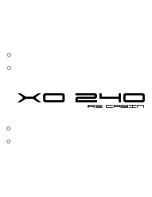
p. 18
Owners Manual
MAINTAINING THE TRAILER
Galvanised trailers are coated in a galvanised finish.
This chemical process bonds very hot liquid zinc to
the trailer and its components. The zinc covering
forms a barrier that protects the steel under the
zinc. The environment in which the trailer is used,
stored and maintained determines the level of
deterioration of the zinc. In areas of high humidity,
high salinity or poor water quality, it is common for
the zinc finish to deteriorate very quickly. A high
level of care is required in these environments.
Trailers must be washed thoroughly after use and
stored in a dry, well ventilated area. Salt residues
may drop onto your trailer from the hull above
while in storage. If this occurs, wash as soon as
possible.
It is normal as the zinc surface ages that a white
powder (calcium carbonate) forms on the
galvanised components. Calcium carbonate is
normally evident in the low drainage points of the
trailer where salt residues collect.
Couplings
Connect the coupling to the tow bar by placing
the coupling directly over the ball, pull up the
handle and let the coupling slide down over the
ball then release the handle letting it bottom out
on the top of the coupling. Mechanical, hydraulic
and standard couplings need to be greased every
six months or when there is no grease
present on the shafts.
Safety Chains
Connect the safety chain to the vehicle with D
shackle supplied with the trailer. Do not use a
padlock between the safety chain and the car
while travelling.
Jockey Wheels
When manoeuvring the trailer on either concrete,
lawn or a soft surface, the jockey wheel should be
in its wound down position. This enables easier
manoeuvring of the trailer.
Axles and Springs
It is recommended that the suspension
components be inspected at least twice yearly
for any evidence of loose u-bolts, bolts and
corrosion or breakage of the leaf springs. Painted
and galvanised suspension components should
be sprayed regularly with products such as lanolin
based sprays.
Wheel Bearings
Wheel bearings should be checked at least every
90 days and before putting the boat away for any
lengthy period. They should be replaced every 6
months depending on trailer use.
For a quick check, jack up the wheel and give it a
wobble from side to side:
If there is slack in the bearing you will need to
retighten the axle hex nut and give the wheel a
spin.
If it is noisy you will need to change the bearings.
If you re-assemble the hub and there is evidence of
water, this will also render the bearings unfit for use
and require replacement.
Routinely check the wheel hubs whenever you stop
for fuel or refreshments. If the hub feels abnormally
hot, inspect the bearings before continuing. On
extended trips, carry spare wheel bearings, seals
and races.
Brakes
If your trailer is braked, the braking system is a disc
brake over-ride system with either mechanical
(cable operated) or hydraulic (fluid operated)
brakes.
At any sign of deterioration, mechanical brake
cables need to be replaced. To adjust the tension
on mechanical brakes ensure the boat, motor and
all equipment are on the trailer. The cable can then
be adjusted at the front pully or the adjustment
bolt on the calliper. Remember to leave enough
slack in the cable to allow for the flex in the trailer
while underway.
Trailers with a gross mass over two tonnes are
fitted with hydraulic electric braking system and
disc braked on all four wheels. This system needs
an in-car electronic electric brake controller to
operate it correctly, owner supplied and fitted
by an auto electrician. The braking unit must be
mounted high over the coupling and kept clear of
submersing and high pressure cleaners at all times.
It is important to check the trailer’s brakes for
operation prior to departure on each trip.
TRAILER INFORMATION







































